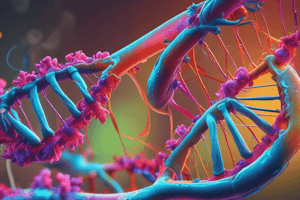Podcast
Questions and Answers
What are the three categories of mutations based on their effects? (Select all that apply)
What are the three categories of mutations based on their effects? (Select all that apply)
- Beneficial (correct)
- Neutral (correct)
- Harmful (correct)
What is the difference between germline mutation and somatic mutation?
What is the difference between germline mutation and somatic mutation?
Germline mutation occurs in gametes and can be passed onto offspring, while somatic mutation occurs in body cells and cannot be inherited.
Induced mutations are caused by exposure to mutagens. True or False?
Induced mutations are caused by exposure to mutagens. True or False?
True (A)
______ mutations occur naturally as a result of errors during DNA replication.
______ mutations occur naturally as a result of errors during DNA replication.
Match the following types of mutagens with their descriptions:
Match the following types of mutagens with their descriptions:
Which of the following is not a type of chemical mutagen?
Which of the following is not a type of chemical mutagen?
Flashcards are hidden until you start studying
Study Notes
Mutations, Mutagens, and Types of Mutations
Introduction to Mutations
- Mutations are permanent changes in the genetic material of a cell that may or may not affect phenotype
- Mutations can be beneficial, neutral, or harmful
- Beneficial mutations lead to evolutionary changes and adaptation to changing environments
- Neutral mutations have no effect on the fitness of the organism
- Harmful mutations cause human diseases and disorders
Classifications of Mutations
- Based on cause:
- Spontaneous mutation: occurs naturally due to errors during DNA replication
- Induced mutation: occurs due to exposure to environmental agents (mutagens)
- Based on tissue/cell of origin:
- Germline mutation: occurs in gametes and can be passed onto offspring
- Somatic mutation: occurs in a single body cell and cannot be inherited
- Based on where the mutation occurs:
- Gene mutation: occurs in a gene
- Chromosomal mutation: occurs in a chromosome
Germline and Somatic Mutations
- Germline mutation: occurs in gametes, every cell in the entire organism is affected
- Somatic mutation: occurs in a single body cell, only tissues derived from mutated cells are affected
Spontaneous and Induced Mutations
- Spontaneous mutation: occurs naturally due to errors during DNA replication, rate of 10-8 to 10-10 per gene per generation
- Induced mutation: occurs due to exposure to environmental agents (mutagens)
Mutagens
- Environmental agents that increase the rate of mutation
- Three types of mutagens:
- Physical mutagens
- Chemical mutagens
- Biological mutagens
Physical Mutagens
- Physical mutagens include sources of electromagnetic radiation, heat, and ionizing radiation
- Examples:
- Ionizing radiation (x-rays and gamma rays) can cause ring opening and fragmentation of bases
- Non-ionizing radiation (UV rays) can lead to cross-linking and generation of nucleotide dimers
- Heat above 95°C causes DNA denaturation
Chemical Mutagens
- Chemical mutagens alter the structure of DNA
- Examples:
- Base analogs: incorporated into DNA instead of normal bases, leading to mutation
- Alkylating agents: alter certain bases of DNA
- Intercalating agents: disrupt DNA structure by intercalating between bases
- Deaminating agents: cause the loss of exocyclic amino groups of nucleotide bases
- Metal ions: produce reactive oxygen species that damage DNA
Biological Mutagens
- Biological mutagens include viruses, bacteria, and transposons
- Examples:
- Viruses: insert their DNA into the genome, disrupting normal function
- Bacteria: cause inflammation, leading to DNA damage and breakage
- Transposons: non-coding DNA sequences that jump from one place to another, influencing gene function
Gene Mutation
- Gene mutations are changes in the nucleotide sequence of DNA
- Two types of gene mutations:
- Point mutation
- Frameshift mutation
Point Mutations
- Point mutation: a single nucleotide base pair change
- Examples:
- Silent mutation: has no effect on the structure and function of the protein
- Nonsense mutation: causes a codon to become a termination codon
- Missense mutation: changes the codon to code for a different amino acid
Frameshift Mutations
- Frameshift mutation: addition or removal of a nitrogenous base from a gene
- Results in the translation of the genetic code in an unnatural reading frame
- Examples:
- Frameshift-deletions: seen in cystic fibrosis, a hereditary disease
- Frameshift-insertions: changes the number of DNA bases in a gene, affecting protein function
Chromosomal Mutations
- Chromosomal mutations involve a change in the structure or number of chromosomes
- Two types of chromosomal mutations:
- Chromosomal aberrations
- Aneuploidy
Chromosomal Aberrations
- Changes in chromosomal structure
- Examples:
- Chromosomal deletions
- Chromosomal duplications
- Chromosomal translocations
Aneuploidy
- Aneuploidy: a change in the number of chromosomes
- Examples:
- Nullisomy: loss of one homologous chromosome pair
- Monosomy: loss of a single chromosome
- Trisomy: one extra chromosome, e.g. Down's syndrome
- Tetrasomy: an extra chromosome pair
Studying That Suits You
Use AI to generate personalized quizzes and flashcards to suit your learning preferences.




